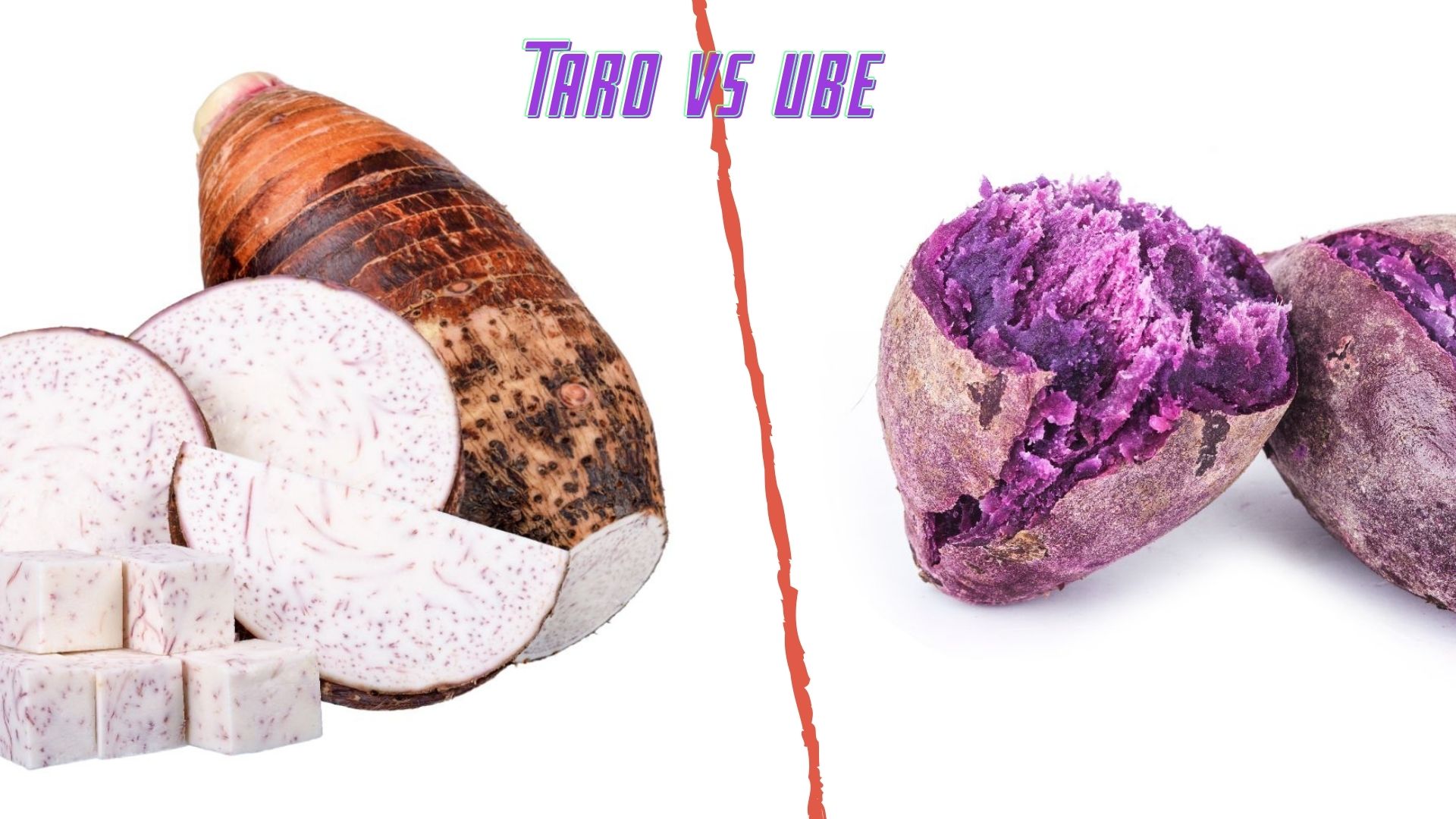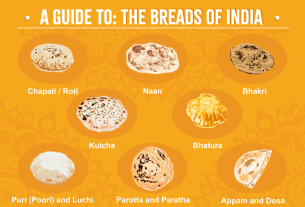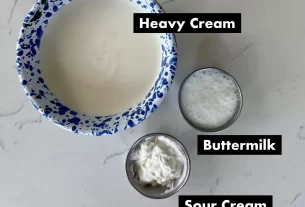Prepare your taste buds for a delectable showdown between two tuber titans: taro and ube.
These starchy wonders may bear a striking resemblance, but don’t be fooled – their flavors are as different as day and night.
From tantalizing milk teas to mouthwatering desserts, these roots have garnered a loyal fan base in culinary circles.
While ube boasts a sweeter profile, hailing from the vibrant kitchens of the Philippines, taro exudes its charm from various tropical corners of the world.
Get ready to embark on a flavorsome adventure as we delve into the battle of taro vs ube.
taro vs ube
In comparing taro and ube, it is important to note that they are both starchy tubers commonly used in milk teas, desserts, and savory dishes.
While they have some similarities in flavor and usage, they also have distinct differences.
Ube is sweeter than taro and is primarily used in desserts, while taro can be used in both desserts and savory dishes.
Additionally, ube has a dark purple color and creamy texture, whereas taro has a light-colored flesh with purple specks.
Both taro and ube offer nutritional benefits and are popular choices in various cuisines.
Key Points:
- Taro and ube are starchy tubers used in milk teas, desserts, and savory dishes
- Ube is sweeter and primarily used in desserts, while taro can be used in both desserts and savory dishes
- Ube has a dark purple color and creamy texture, while taro has light-colored flesh with purple specks
- Both taro and ube offer nutritional benefits
- Taro and ube have some similarities in flavor and usage
- Taro and ube are popular choices in various cuisines
taro vs ube – Watch Video
💡
Pro Tips:
1. The taro root, also known as dasheen, is believed to have originated in Southeast Asia and has been cultivated for over 6,000 years.
2. Ube, a purple yam native to the Philippines, is commonly used in traditional Filipino desserts and is known for its vibrant hue and distinct sweet flavor.
3. Taro leaves are not only used in cooking, but some cultures also use them for medicinal purposes, as they are believed to have anti-inflammatory and detoxifying properties.
4. Ube is rich in antioxidants, particularly anthocyanins, which give it its vibrant purple color and have been linked to various health benefits, such as reducing inflammation and improving heart health.
5. Both taro and ube are versatile ingredients that can be used to make a wide range of dishes, from savory taro chips and taro bubble tea to sweet ube ice cream and ube halaya (a Filipino pudding).
Introduction To Taro And Ube
Root vegetables such as taro and ube have become increasingly popular in global cuisine due to their distinctive flavors and vibrant colors. Both taro and ube are starchy tubers commonly incorporated into a variety of dishes, including milk teas, desserts, and savory delicacies. However, these two root vegetables differ in terms of their origins, unique taste profiles, and culinary applications. This article aims to provide an insight into the nutritional composition, flavor attributes, and cultural significance of taro and ube.
Ube: The Purple Yam From The Philippines
Ube, also known as the purple yam, is a root vegetable native to the Philippines. With its distinctive deep purple color, which intensifies when cooked, Ube has been an integral part of Filipino cuisine for ages. Beyond its visual appeal, Ube offers a range of nutritional benefits. This fibrous vegetable is packed with antioxidants, carbohydrates, potassium, and vitamin C, making it a valuable addition to any diet.
Nutritional Benefits Of Ube
One of the notable health benefits of ube is its potential to help prevent diabetes. The high fiber content in ube can aid in stabilizing blood sugar levels, reducing the risk of spikes and dips. Additionally, the antioxidants present in ube help combat oxidative stress and inflammation in the body. Ube is also a good source of carbohydrates, providing a steady source of energy, and its vitamin C content promotes a healthy immune system. Moreover, the potassium content in ube contributes to proper heart and muscle function.
Ube: Color, Texture, And Flavor
The purple color of ube makes it visually appealing and often used to enhance the appearance of various dishes. Its vibrant hue adds a pop of color to bread, cakes, ice cream, and other baked goods.
In terms of texture, ube has a creamy consistency when cooked and mashed. Its flavor is subtly sweet with nutty and vanilla undertones, making it a versatile ingredient that can be used in both sweet and savory dishes.
- Ube adds a visually appealing element to dishes
- Versatile ingredient suitable for both sweet and savory dishes
- Creamy consistency when cooked and mashed
“The purple color of ube makes it visually appealing and often used to enhance the appearance of various dishes.”
Popular Uses Of Ube In The United States
In recent years, ube has gained popularity in the United States, particularly in the realm of boba tea and desserts. Its unique flavor profile and vibrant color make it a sought-after ingredient in the milk tea trend, adding a delightful twist to classic drinks.nUbe-flavored ice cream has also become a favorite among dessert enthusiasts, offering a sweet and creamy treat with a hint of nuttiness. The growing popularity of ube in the United States highlights the influence of Filipino cuisine and the appreciation for its rich flavors.
- Ube is gaining popularity in the United States.
- Ube is commonly used in boba tea and desserts.
- Its unique flavor profile and vibrant color make it sought-after.
- Ube-flavored ice cream is a favorite among dessert enthusiasts.
- It offers a sweet and creamy treat with a hint of nuttiness.
“The growing popularity of ube in the United States highlights the influence of Filipino cuisine and the appreciation for its rich flavors.”
Ube In Filipino Cuisine
In Filipino cuisine, ube is used in various traditional dishes and desserts. Boiled and mashed with condensed milk, it is often transformed into rich and creamy treats like jam or coconut ube pudding. Ube is also commonly used to color and flavor bread, cakes, and other baked goods, creating visually striking and flavorful creations. The versatility of ube allows it to be incorporated into both sweet and savory dishes, showcasing its culinary significance in Filipino culture.
- Boiled and mashed with condensed milk
- Ube jam or coconut ube pudding
- Coloring and flavoring bread, cakes, and other baked goods
Taro: A Versatile Tuber From Southeast Asia
Taro, a popular root vegetable, originated in Southeast Asia and is also grown in India, Hawaii, and Australia. It has been a dietary staple in African, Indian, and South Pacific Island cuisines for centuries. The name “taro” comes from the Māori word meaning “bread,” emphasizing its importance as a staple food. Known for its versatility, taro can be used in various sweet and savory dishes.
- Taro has its origins in Southeast Asia and is cultivated in India, Hawaii, and Australia.
- It has been a staple in cuisines across Africa, India, and South Pacific Islands for centuries.
- The name “taro” comes from a Māori word meaning “bread,” highlighting its significance as a staple food.
- Taro is versatile and can be used in both sweet and savory dishes.
Taro’s Cultural Significance And History
Taro, a crop with a rich history, holds immense cultural significance in many societies. With roots dating back thousands of years, it stands as one of the earliest domesticated crops. In Polynesian cultures, taro is revered as a sacred plant, symbolizing both fertility and prosperity. Traditional ceremonies and celebrations often incorporate taro, showcasing its importance. This deep-rooted connection to communities highlights taro’s role as a staple food, providing sustenance for generations.
- Taro is one of the earliest domesticated crops, dating back thousands of years.
- In Polynesian cultures, taro symbolizes fertility and prosperity.
- Taro is commonly used in traditional ceremonies and celebrations.
- Its significance lies in its role as a staple food for many generations.
“Taro reflects its deep-rooted connection to the communities that have relied on it as a staple food for generations.”
Taro: Health Benefits And Fiber Content
Taro is a versatile ingredient that offers both delicious taste and numerous health benefits. Similar to ube, taro is an excellent choice for a heart-healthy diet because of its low fat and cholesterol content. Not only that, but taro is also a great source of dietary fiber, which aids in digestion, promotes satiety, and regulates blood sugar levels.
Additionally, taro is packed with essential vitamins and minerals. It contains vitamin E, vitamin B6, potassium, magnesium, and iron. These nutrients play crucial roles in maintaining overall health. For example, vitamin E is beneficial for a healthy immune system, while vitamin B6 supports cognitive function.
To summarize, taro not only tantalizes the taste buds but also provides a wide range of health benefits such as:
- Heart-healthy choice due to low fat and cholesterol content
- Rich in dietary fiber for better digestion and blood sugar regulation
- Packed with essential vitamins and minerals for maintaining bodily functions.
“Let food be thy medicine and medicine be thy food.” – Hippocrates
Comparing The Differences Between Ube And Taro
While both taro and ube are starchy tubers used in milk teas, desserts, and savory dishes, they have distinct characteristics that set them apart:
- Ube has a dark purple flesh, while taro has lighter-colored flesh with purple specks.
- Ube is known for its intense sweetness with nutty and vanilla undertones, while taro offers a more subtle flavor profile.
- Ube is primarily used in desserts, while taro finds its place in both sweet and savory dishes.
It is important to note that the leaves and raw flesh of the taro plant are toxic and must be cooked appropriately to avoid illness.
Overall, both taro and ube are unique and beloved root vegetables with their own set of distinctive qualities. They bring an array of colors, textures, and tastes to various dishes and recipes. Whether you are indulging in a rich ube-flavored ice cream or savoring a taro-filled dumpling, both root vegetables are sure to delight your taste buds and provide a memorable dining experience.
- Taro has lighter-colored flesh with purple specks.
- Ube is known for its intense sweetness with nutty and vanilla undertones.
- Taro is versatile and used in both sweet and savory dishes.
- It is important to cook the leaves and raw flesh of the taro plant appropriately to avoid illness.
“Both taro and ube are unique and beloved root vegetables with their own set of distinctive qualities.”
💡
You may need to know these questions about taro vs ube
Is ube and taro the same?
Taro and ube may share some similarities, but they are not the same. Taro originates from Southeast Asia and has roots that are white or light purple in color, whereas ube, also known as purple yam, is native to the Philippines and has distinctively purple roots. Moreover, their flavors and traditional uses differ as well, with taro often being described as nutty in taste and commonly used in savory dishes, while ube has a sweeter flavor and is frequently used in desserts and pastries. So, although taro and ube may be similar in some ways, their origins, root colors, flavors, and traditional uses set them apart.
Is taro or ube better?
While both taro and ube have similar calorie counts, their nutritional profiles differ. Taro is known for its high fiber content, which aids digestion and promotes a healthy gut. Additionally, taro contains essential minerals such as potassium and magnesium, which are important for maintaining electrolyte balance and overall bodily functions. On the other hand, ube contains a higher amount of sugar and possesses antioxidant properties, which can provide various health benefits. Due to its low glycemic index, ube’s slow digestion can assist in regulating blood sugar levels. Ultimately, the choice between taro and ube depends on your specific dietary needs and preferences.
Does ube Boba taste like taro?
While both ube and taro are root vegetables with purple hues, they possess distinct flavor profiles. Ube boba does not taste like taro, as ube’s flavor exhibits a sweeter, deeper, and slightly richer taste. With its popularity in Filipino and Pacific Islander cuisine, ube is commonly utilized in various sweets and desserts, contributing to its unique and distinct flavor experience.
Is taro actually purple?
Taro, often mistaken for its vibrant counterpart ube, possesses a distinctive appearance that sets it apart. Contrary to popular belief, taro is not inherently purple. Its outer layer, covered in a brown and fuzzy coat, conceals a flesh that can either be white or adorned with light purple specks. Upon cooking, the flesh assumes a delicate shade of grey or purple, lending a subtle and pleasing hue to various dishes.
Reference source
https://drizzlemeskinny.com/ube-vs-taro-whats-the-difference/
https://pochibubbletea.com/blog2/what-is-taro-what-is-ube
https://www.allrecipes.com/ube-vs-taro-difference-7496040
https://yishifoods.com/blogs/blog/what-is-taro-milk-tea



